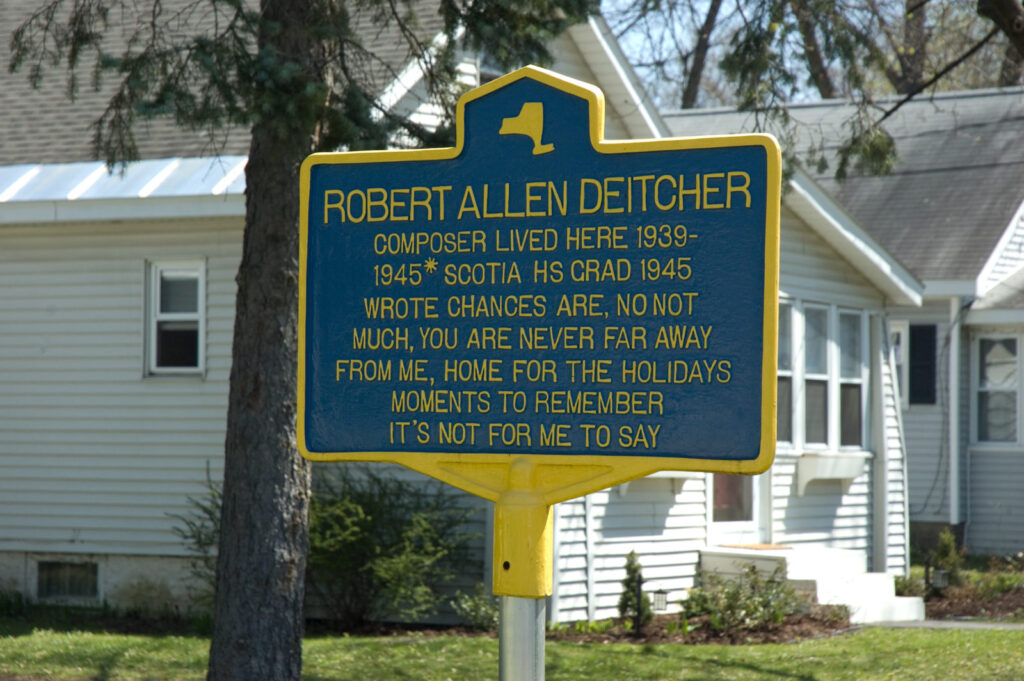One would think that if a composer of incredibly famous songs had once lived just a few blocks from one’s childhood home, one would have heard about it, no? But we didn’t know until this historic marker went up, sometime after 2000, that the composer Robert Allen (full name Robert Allen Deitcher) lived for several years at 528 Charles Street in Scotia, and graduated from Scotia High School. And even knowing some of his songs, it must be said that his name is not terribly well known, so we’re grateful for whoever was behind creating this marker.

Robert Allen Deitcher was born to a Jewish family in Troy, in 1927. We haven’t found much about his family of origin; several Deitchers listed in Troy appear to have immigrated from Russia. What the family did or how they came to be in Schenectady or Scotia, we didn’t learn, though there is a Charles Deitcher living in Schenectady around this time with a business listed in Troy. Robert first turns up in 1937, participating in the Soap Box Derby, which was a very, very big thing in Schenectady at the time; he was listed as living at 1451 State Street. Two years later, he was listed on the program of the closing exercises of the Nott Terrace Hebrew School. Then he was in Scotia for junior high and high school, where he was frequently on the honor roll and busily participated in Boy Scouts (Troop 63), basketball, and band.
In 1941, “Robert Deitcher of room 202 was crowned ninth grade and school ping-pong champion for the year in a recently concluded contest at Scotia Junior High school.” He was part of the high school band that participated in a broadcast over WGY in 1943 that included “patriotic selections and marches written by John Philip Sousa,” which they had also recently played at the dedication of the Scotia Naval Supply depot, not far from the high school itself. He is listed on a number of musical programs; unfortunately, his instrument is never mentioned. When he graduated with the January 1945 graduating class, he gave the salutatory address. (The January class, which included 30 students, would normally have joined in a June commencement, but in this case there was a special commencement “so that boys, entering the service, might have diplomas prior to induction.” That applied to four of the 30.)
After that, we haven’t found much to explain his path to being a very successful composer. Two biographies claim that he passed up a scholarship to RPI to pursue music, and a fan page (though perhaps it’s family?) says that he went to NYC to play jazz piano. An article from Jazztimes.com says that in 1952, he joined NBC as a house composer. Throughout the ’50s, he wrote the music for a number of hit songs that are now romantic standards, including “Chances Are” and “It’s Not For Me to Say,” both made famous by Johnny Mathis, several hits for Perry Como, and “Home for the Holidays.” (Lyrics for all those were by Al Stillman.)
The New York Times included the following in his obituary in 2000:
“Mr. Allen was born in Troy, N.Y., and after graduating from high school in 1945, he passed up an engineering scholarship to Rensselaer Polytechnic Institute to become a musician. He played jazz piano in New York clubs, started writing music in 1952 and began working for television shows. He wrote ‘You Are Never Far Away From Me,’ the closing song for ‘Perry Como’s Kraft Music Hall’; ‘Sing Along’ for Mitch Miller’s series ‘Sing Along With Mitch’; ‘A Very Special Love’ for CBS’s ‘Playhouse 90’; and music for ‘The Archie Show.’
“He wrote his biggest hits with the lyricist Al Stillman. They collaborated on ‘Chances Are’ and ‘It’s Not for Me to Say,’ which were major hits for Johnny Mathis, and on a series of hits for the Four Lads in the mid-1950’s, including ‘Moments to Remember,’ ‘Enchanted Island’ and ‘There’s Only One of You.’ They also wrote ‘Home for the Holidays,’ which has been recorded by more than two dozen performers, including Andy Williams, the Glenn Miller Orchestra and Garth Brooks.”
We knew none of this until one day when we were visiting the old home town and just chanced upon this marker, which was certainly never there before. It probably turned up after his death in 2000, though who was responsible for putting it up we don’t even know. But we’re always glad to see a new historical marker, especially one that brings up a story that we’d never heard before.

Leave a Reply